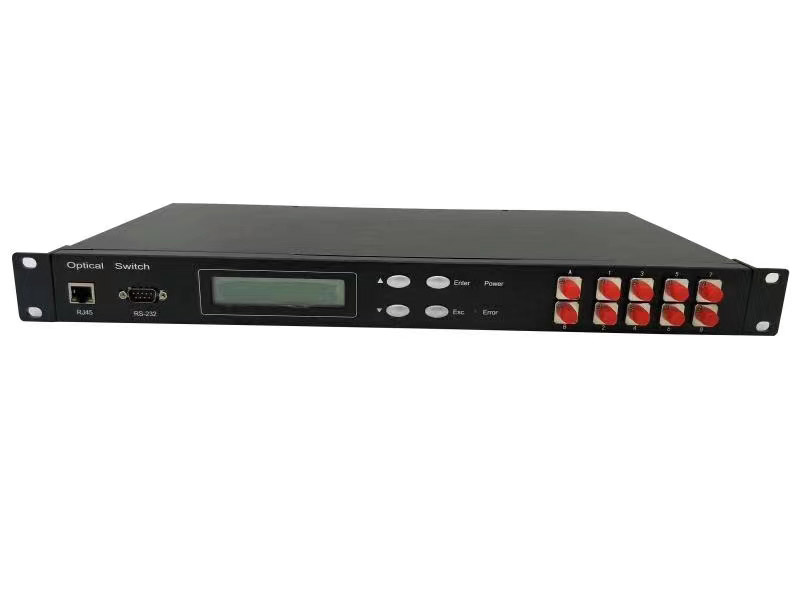What are the key indicators for selecting an optical switch?
Optical switch are critical components in optical communication networks, enabling precise and reliable switching of optical signals. Choosing the right optical switch requires familiarity with its key performance indicators. The following are key indicators for selecting an optical switch:
1. Switching Time
Switching time refers to the time it takes for an optical switch to change from one state to another (from one channel to another, or from on to off). This metric is particularly important in dynamic optical networks that require fast signal routing. Switching times are typically measured in milliseconds (ms) or microseconds (μs). If microsecond-level switching speeds are required, magneto-optical switches are the obvious choice. If millisecond-level switching speeds are required, MEMS optical switches, relay-type optical switches, and motor-type optical switches can meet the requirements.
2. Wavelength Range
The wavelength range of an optical switch defines the spectral range in which it can operate effectively. In optical networks, data is transmitted over various channels using different wavelengths, making it important to select an optical switch that can handle the wavelength range required for a specific application. A wide operating wavelength range provides greater flexibility and compatibility with different types of optical signals and systems.
3. Insertion Loss
Insertion loss is a key specification to consider when selecting an optical switch. It refers to the amount of signal power lost when the optical switch is introduced into the optical path. Measured in dB, lower insertion loss values indicate better performance because less signal power is lost. High insertion loss can lead to degraded signal quality and reduced optical network efficiency. When evaluating optical switches, choose one with the lowest insertion loss to maintain signal integrity.
4. Return Loss
Return loss measures the amount of signal reflected back to the source due to impedance mismatches within the optical switch. Measured in dB, higher return loss values indicate less signal reflection. Reflected signals can interfere with the original signal, leading to potential errors and degraded network performance. Optical switches with high return loss ensure signal integrity, minimizing the risk of interference.
5. Crosstalk
Crosstalk is a measure of the isolation between optical switch ports. It is typically measured in dB as the ratio of the optical power at an input port to the optical power measured at a non-output port after an optical signal is input. Crosstalk is dependent on the input wavelength and the optical switch state.
6. Lifespan and Reliability
Lifespan and reliability are key factors in the long-term performance of optical switches. Lifespan is typically measured by the number of switching cycles a device can perform without significant performance degradation. Reliability, on the other hand, refers to the switch’s ability to maintain consistent performance under varying environmental conditions. Considering both of these metrics when selecting an optical switch ensures the switch can meet application requirements and provide stable and reliable operation over time.
7. Maximum Allowable Optical Power
The maximum allowable optical power represents the maximum optical power an optical switch can handle without performance degradation or damage. In networks using amplified signals, such as those containing erbium-doped fiber amplifiers (EDFAs), it is essential to select an optical switch capable of handling high power levels to avoid potential failures.
8. Form Factor
The form factor of an optical switch impacts the design and integration of the optical system. In space-constrained environments such as data centers or optical network units (ONUs), compact optical switches are often preferred. At the same time, size should not compromise the performance of the optical switch.
9. Environmental Stability
Environmental stability is a key criterion when selecting an optical switch. Optical switches often operate in environments with varying temperature conditions, so it is important to select an optical switch that can maintain performance under a variety of environmental conditions. This includes stability in temperature range, humidity tolerance, and resistance to shock and vibration. Choosing an optical switch with proven environmental stability ensures consistent performance even under challenging conditions.
Xionghua Photoelectric offers a full range of optical switch products, including magneto-optical switches, MEMS optical switches, motor optical switches, mechanical optical switches, matrix optical switches, optical switch modules, and rack-mount optical switches.For special fiber types and wavelengths, please contact our sales representatives.

Comments are closed